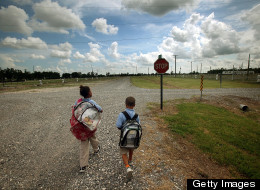In June, Mitt Romney told Virginians on the campaign trail that he wanted "to make sure that we keep America a place of opportunity..."
"...where everyone has a fair shot. They get as much education as they can afford and with their time they’re able to get and if they have a willingness to work hard and the right values, they ought to be able to provide for their family and have a shot of realizing their dreams."
Except if everyone is to have "a fair shot," then they likely need to get more education than they "can afford."
July 12, the American Civil Liberties Union of Michigan, along with eight students, filed a lawsuit against the state and the Highland Park School District for failing to see that children were reading at their grade level.
One student, Quentin, a 14-year-old boy who had completed seventh grade but still reads at a first-grade reading level, wrote:
My name is Quemtin and you can make the school gooder by geting people that will do the jod that is pay for get a football tame for the kinds mybe a baksball tamoe get a other jamtacher for the school get a lot of tacher.
Quentin attends a school that is struggling to balance its books, where poverty is rampant and little inovation is tried to get it back on track.
Nearly 60,000, or three-quarters of the nation's schools reported not being in good condition as they needed "repairs, renovations, or modernization. Not surprisingly, most schools in bad condition are in cities where at least 70 percent of students are below the poverty line."
Poverty among children in America is shamefully high. According to aUNICEF report, U.S. child poverty rate is 23.1 percent -- higher than any other economically advanced nation except Romania.
In March 2010, America's Promise Alliance, nation’s largest partnership dedicated to improving the lives of children and youth, launched their "Grad Nation Campaign" to research and ensure more students complete their education. According to the report:
...nearly all of the high-poverty urban school districts that have improved still have graduation rates below the national average. Too many graduates are still unprepared for the needs of college and high-wage employment.
Poverty continues to be the No. 1 impediment to educational success, as children of poor families are more likely to drop out than wealthy children, and the report suggests that solutions have yet to be found for high-poverty school districts:
School budgets are tied to property taxes. This is why schools in poor neighborhoods get about half as much money per student than schools in affluent neighborhoods.
To make generational progress for students from low-income families and prepare them to be successful in secondary and post-secondary education, many say change must be student-centered. But nationally, education standards are intimately tied to income.
According to a Newday Article, a Standford University professor Linda Darling-Hammond points out, "U.S. 15-year olds in schools with fewer than 10 percent of kids eligible for free or cut-rate lunch "score first in the world in reading, outperforming even the famously excellent Finns."
It is clear the link between environments in which economic struggle is rampant directly impact educational success in the classroom. This inability to perform in schools, then impacts how competitive American students will be in the workplace. The edge is not yet lost, however, if the United States can figure out how to maintain its education standards and do something about students struggling with poverty, the report states.
"The challenge is that, to date, high-poverty urban districts, even after substantial improvement, have not been
able to move beyond graduation rates in the 60th percentiles. For the nation as a whole to move forward, we must find ways to both advance the city school districts that have not made substantial progress and accelerate and then maintain the rate of progress in those that have."

The Huffington Post | By Samreen Hooda Posted: 08/30/2012